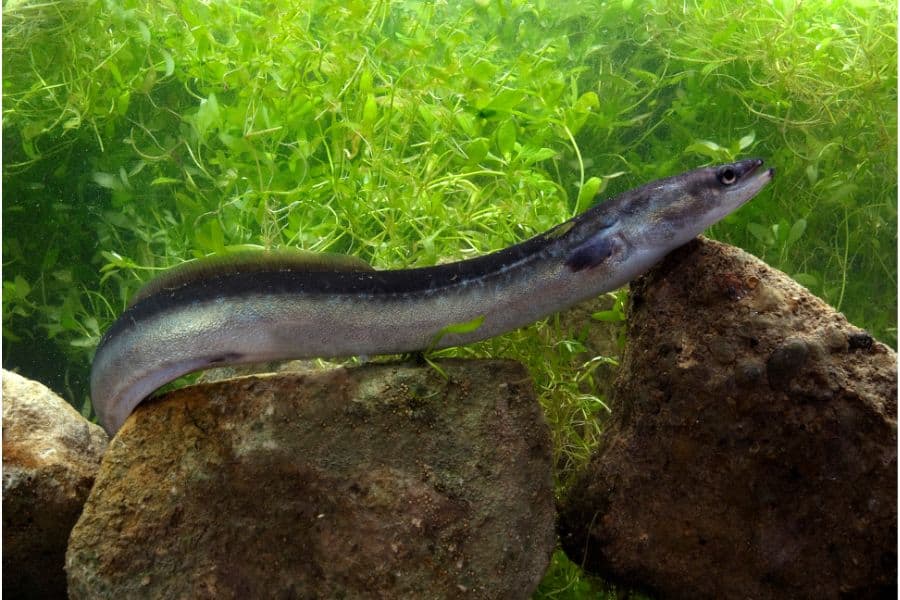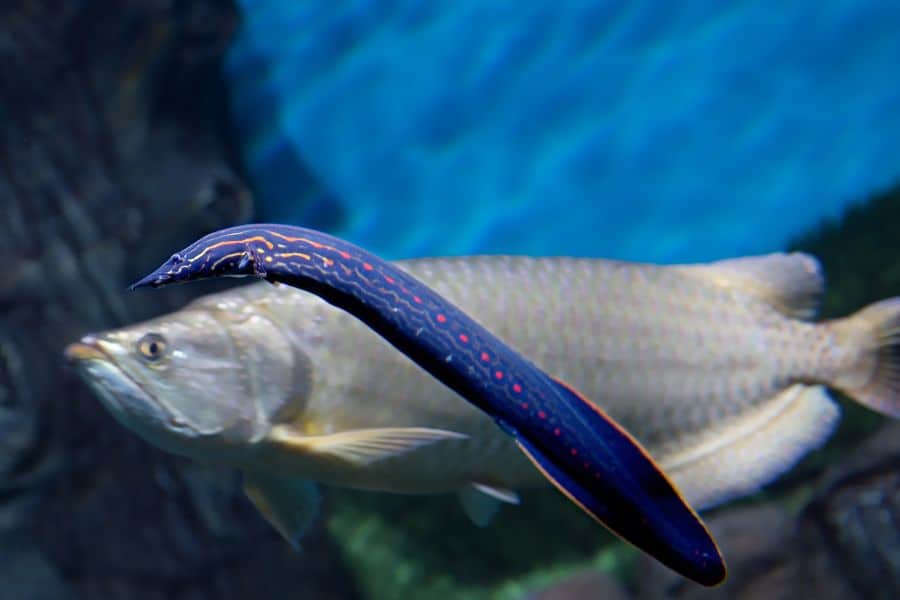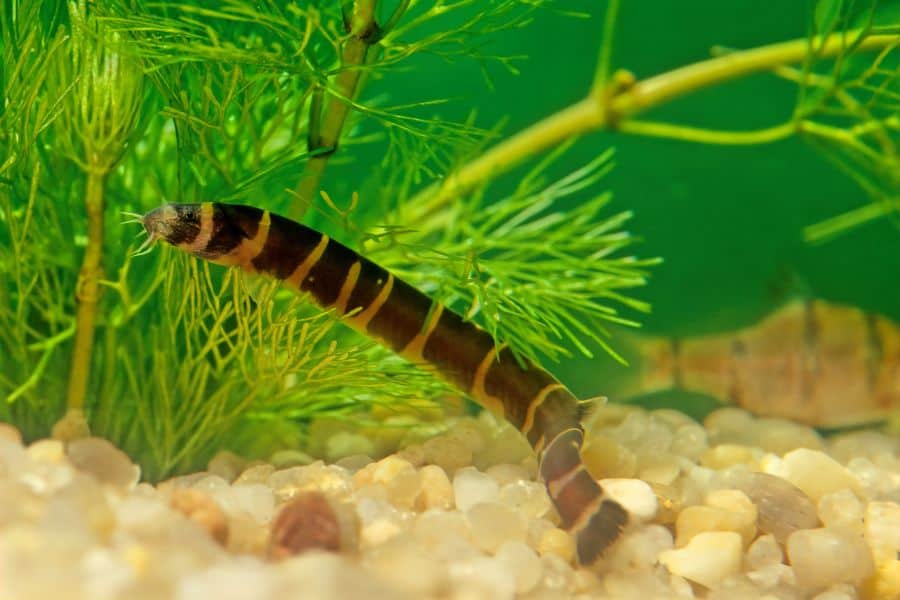You wouldn’t know it, but eels make for interesting aquarium pets. With their ease of care, interesting personalities, and fantastic looks, what’s not to like?
However, it’s important to note that taking care of this curious pet comes with its own set of responsibilities. Like other fishes, they also have water parameter needs and specific care requirements.
If you want to care for some fascinating eels, you need to learn everything you can about them. It can be confusing, but don’t worry – we’ll discuss everything you need to know in this article.
Fast Facts About Freshwater Eels
Before we get to the bulk of our article, here are some fascinating facts about these long creatures.
Incredible Shape-Shifting
As eels grow, they undergo remarkable transformations in their bodies. Initially, they start as transparent larvae known as leptocephali, and as they mature, they gradually develop into the elongated, snakelike form we associate with eels.
Longevity Beyond Belief
Some species of eels are known for their impressive longevity in captivity. Some species can live for several decades in the right conditions. Imagine having a lifelong aquatic companion your grandchildren can still care for!
Mythical and Cultural Significance
Eels have held cultural and mythological significance in various societies.
The giant mottled eel (Anguilla japonica) is considered a delicacy in Japan. They even have a dedicated event where they celebrate and consume this eel, called the Unagi Festival.
Korea, China, and other countries also consider eels a delicacy.
Learning about the cultural significance of eels in various parts of the world can add a touch of depth to your appreciation for the aquatic beings that you’ll soon be raising in your aquarium.
Toxic Blood
Never eat eel raw! Cultures that love sushi and raw fish meat always cook it because eels have blood with proteins that can cause muscle spasms and can even be lethal to humans. The toxins do break down when the eel is cooked.
Electric Eel’s Shocking Abilities
Electric eels, a type of knifefish found in freshwater rivers, can generate electric shocks to navigate, locate prey, and communicate.
While they aren’t suitable for most home aquariums due to their size and specialized care requirements, their electrifying nature is a fascinating natural phenomenon to learn about.
12 Types of Freshwater Eels for Aquarium
Now, let’s get to the best part – the 12 most popular types of freshwater eels that you can keep for your aquarium!
Before we do that though, let’s differentiate three types of eels you’ll find: true eels, eel fish, and eel-like fish.
True Eels
True eels are those that belong to the Anguilliformes order, while the rest are simply fish that have eel-like characteristics.
This order consists of 19 families and over 900 species. Only 1 family lives in freshwater, the Anguillidae, which consists of around 20 species. The rest live in brackish or saltwater habitats.
The main difference between true eels and non-true eels is typically the internal body structure. True eels don’t have pelvic fins, with many of these species not having pectoral fins either. Their dorsal, caudal, and anal fins run continuously, and they’re centered around their tail fins.
Unfortunately, all true freshwater eels are catadromous, which means they will eventually need to move to either brackish or saltwater as adults in order to spawn, even those who live most of their lives in freshwater.
That’s why it’s rare to find true eels in home aquariums – captive ones are typically housed in public aquariums or sanctuaries.
Eel Fish
Some fish species officially have the word “eel” in their name despite not being classified as “true” eels. These fish are also ray-finned fishes like the true eels, but they have spiny rays instead.
1. Fire Eel
- Scientific Name: Mastacembelus erythrotaenia
- Care Level: Moderate
- Standout Feature: Fire-like coloration
- Temperament: Semi-aggressive
- Adult Size: 20 inches
- Minimum Tank Size: 80 gallons
- Diet: Carnivore
- Tank Setup: Soft substrate, dim lighting, and floating plants only.
This freshwater species is a dazzling aquatic spectacle that can steal the spotlight in any aquarium. Its vibrant, fiery-red marks run along its elongated matte black body, hence its name.
That said, fire eels are actually not real eels but rather a very elongated fish species. Still, although they’re not true eels, they’re still quite popular in the eel-loving side of the hobby.
Aside from their striking appearance, this eel species is also well-loved for their peaceful temperament, which is rare from other eel species, making them compatible with larger, non-aggressive fish.
Caring for a fire eel involves providing a roomy aquarium without many plants, as these eels can grow up to 20 inches or more and can easily uproot any plant that might be in the tank.
2. Yellow Tail Spiny Eel
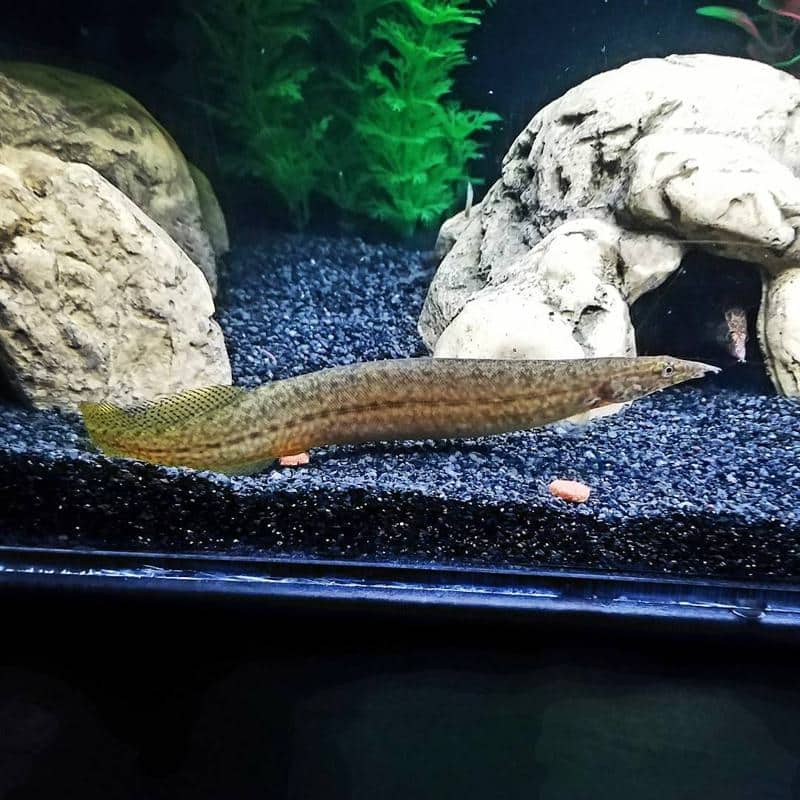
- Scientific Name: Macrognathus pancalus
- Care Level: Moderate
- Standout Feature: Small size and yellow tail
- Temperament: Semi Aggressive
- Adult Size: 7 inches
- Minimum Tank Size: 30 gallons
- Diet: Carnivore
- Tank Setup: Planted tank with sandy substrate and hiding places.
This remarkable eel species boasts attractive features that make it ideal for a home aquarium.
First is their appearance. They have a strikingly bright yellow tail fin that grabs the attention of onlookers and makes them look like tiny dragons.
Second is their size. Unlike other eel species, the yellow tail spiny only grows about 7 inches. They are still comparatively large by fish standards, but they make for smaller tanks than the previously mentioned fire eel.
Because of their small size, they are also not as prone to hunting other fish. Eels typically attack animals smaller than they are, and with how small this species is, you can keep “normal-sized” fishes with them, such as barbs.
They appreciate the presence of hiding spots like caves or PVC pipes in the aquarium and won’t say no to having lots of plants like their original habitats.
3. Peacock Eel
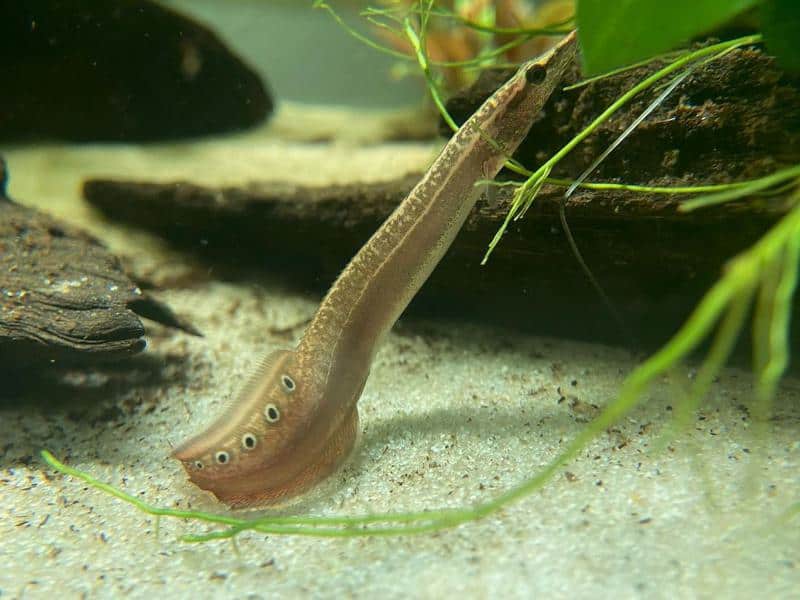
- Scientific Name: Macrognathus siamensis
- Care Level: Moderate
- Standout Feature: Interesting patterns
- Temperament: Peaceful
- Adult Size: 12 inches
- Minimum Tank Size: 30 gallons
- Diet: Carnivore
- Tank Setup: Soft substrate with lots of hiding places and dense vegetation.
If you want an eel that boasts captivating and intricate patterns, the peacock eel is a great species to get.
They have a predominantly light-colored body and a mixture of bright white and black colored marks that form patterns, especially towards the tail end of their body.
Peacock eels are relatively small, typically growing to around 8-10 inches long, making them suitable for smaller aquariums.
Their peaceful temperament makes them compatible with a variety of tankmates, too. You can house individuals in a sandy and cover-rich 30-gallon community tank with other fish species.
4. Zigzag Eel
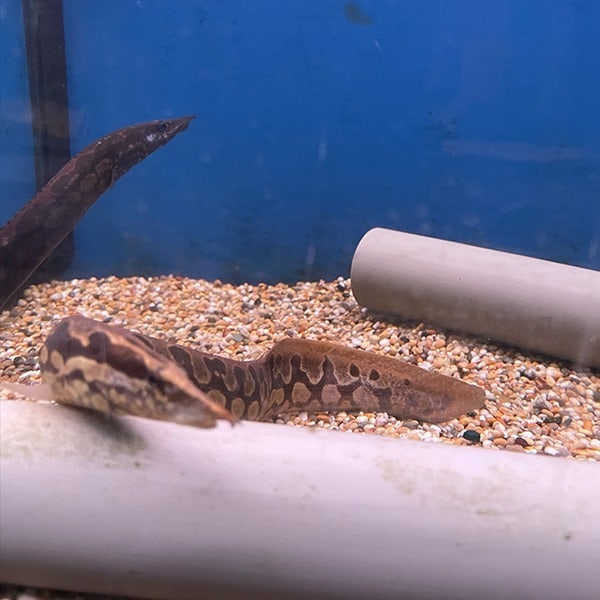
- Scientific Name: Mastacembelus armatus
- Care Level: Moderate
- Standout Feature: Zigzag patterns
- Temperament: Peaceful
- Adult Size: 20 inches
- Minimum Tank Size: 35 gallons
- Diet: Carnivore
- Tank Setup: Big tank with soft substrate and lots of cover
Recognizable by its unique pattern resembling zigzags, this eel is another popular choice for exotic home aquarium setups.
Their main feature is their continuous, almost-geometric pattern that runs along their elongated body, which has also earned them the nickname “tire track” eels.
Aside from the cool backstory of their name, they are also relatively easy to care for and are able to tolerate slight changes in water parameters.
They’re carnivores, so they tend to prey on fishes that are smaller than they are.
Nonetheless, they tend to be very timid in the tank, leaving bigger species alone, and thus can easily coexist with others in a community tank. Feed them with live or frozen critters like shrimp, earthworms, and more to keep them happy.
Like other eels, they thrive best in big tanks with lots of floor area, soft or sandy substrate, hiding places, and vegetation.
5. Half-Banded Spiny Eel
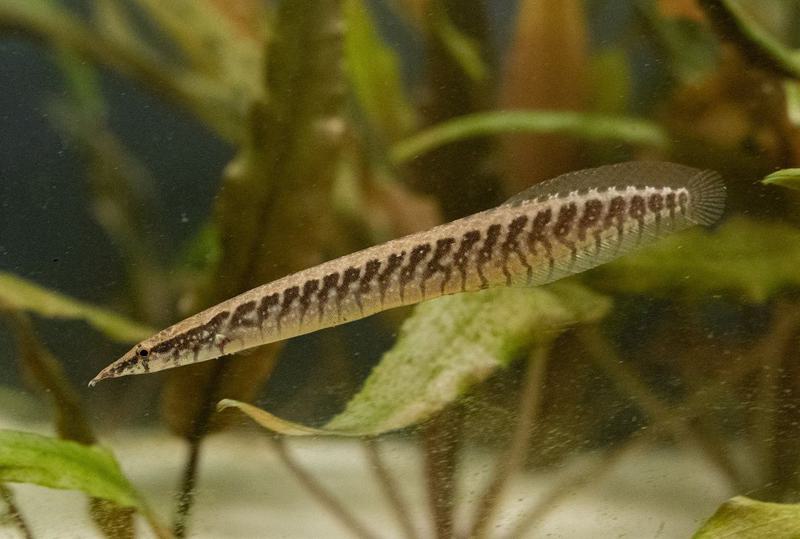
- Scientific Name: Macrognathus circumcinctus
- Care Level: Advanced
- Standout Feature: Banded patterns
- Temperament: Semi-aggressive
- Adult Size: 8 inches
- Minimum Tank Size: 35 gallons
- Diet: Carnivore
- Tank Setup: Sand substrate, Indian Almond leaves, and low-lighting
Affectionately called the half-banded spiny, this is a small-sized eel that does well in a medium-sized aquarium, although it might not be for beginners.
Their main feature is the banded patterns on their back, where they got their name. They exhibit half-bands of dark marks on a lighter body, with colors ranging from brown to dark gray.
Their patterns and elongated head and body shape can make them look like small snakes in your aquarium.
They need a soft, deep layer of fine substrate like sand, as they often bury themselves in it to hide during the day, with only their snouts visible. As such, they also appreciate additional “cover,” such as Indian Almond leaves, that also stimulate a salty environment.
If you want, you can house them with large fish, as they will likely prey on fish that can fit in their mouths. Species like gouramis, oscars, and plecos will do nicely as neighbors.
6. African Starry Night Eel
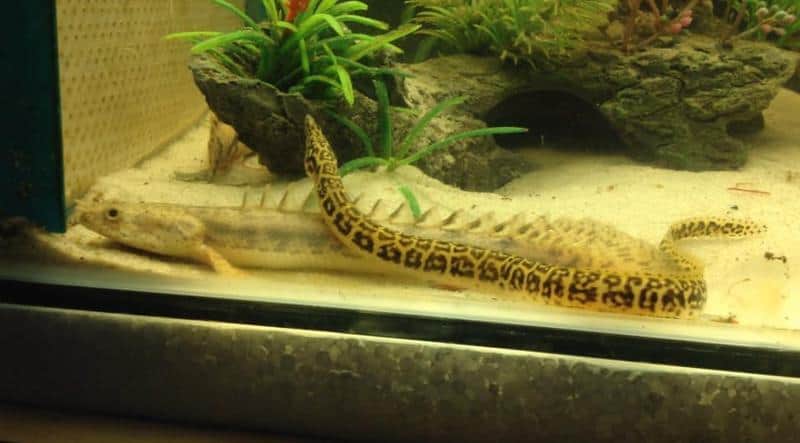
- Scientific Name: Mastacembelus frenatus
- Care Level: Moderate
- Standout Feature: Interesting body pattern
- Temperament: Semi-aggressive
- Adult Size: 15 inches
- Minimum Tank Size: 30 gallons
- Diet: Carnivorous
- Tank Setup: Soft sandy substrate
Also called longtail spiny eel, this species is one of the smaller members of the spiny eel family, maxing their adult size at about 15 inches and making them much more manageable for home aquariums.
Their main feature is the light dots and tiny patterns on their bodies, reminiscent of the starry night for which they were named.
Because of their small size, they can usually be housed with other normal-sized community fish without them hunting their neighbors for food. But just be reminded to take extra care when feeding, as they can be very slow eaters and be out-competed by the others in the tank.
Aside from that, they are also uncommonly hardy and more outgoing than their other eel cousins, making them a delight in any community tank.
7. Indian Mud Moray Eel
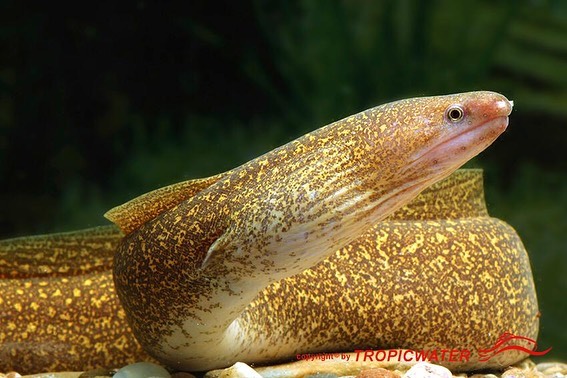
- Scientific Name: Gymnothorax tile
- Care Level: Experienced
- Standout Feature: Personalities
- Temperament: Semi-aggressive
- Adult Size: 20 inches
- Minimum Tank Size: 30 gallons
- Diet: Carnivore
- Tank Setup: Brackish water with plenty of hardscaping and caves
Straddling the line between marine and freshwater, the Indian Mud Moray Eel can be found in brackish waters, estuaries, and mangrove areas.
While they are called a species of freshwater moray eel, they’re not true freshwater inhabitants. They often venture deeper into land when spawning or during their seasonal migration patterns and are caught there – hence the name.
However, they do well in captivity, given that their requirements of very salty water are met, and they make great pets because of their intelligent personalities and exotic looks.
8. Pink Paddle Tail Eel
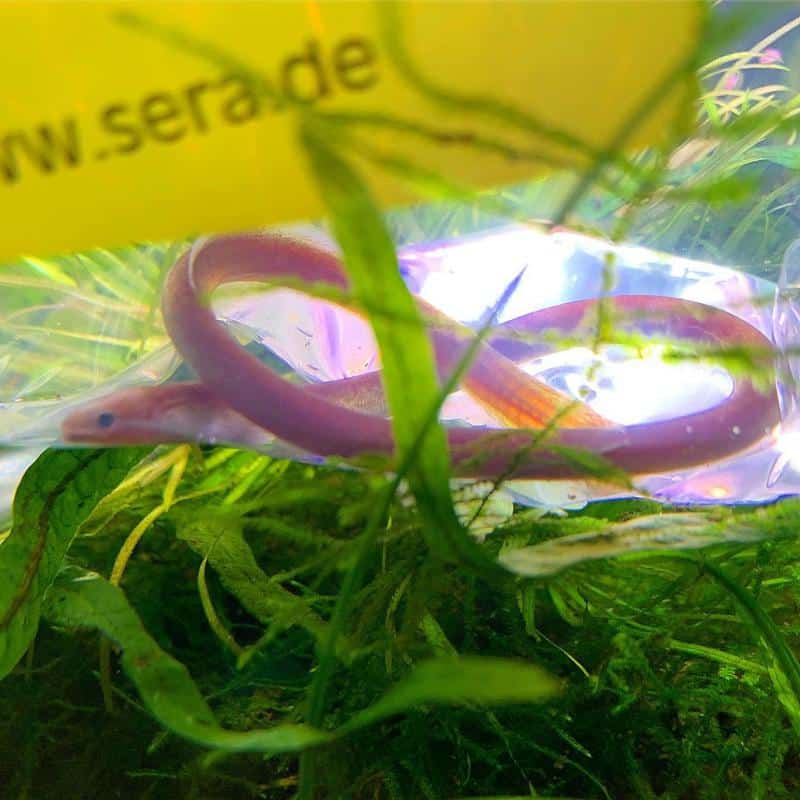
- Scientific Name: Moringua raitaborua
- Care Level: Advanced
- Standout Feature: Pinkish color and personalities
- Temperament: Semi-aggressive
- Adult Size: 17 inches
- Minimum Tank Size: 30 gallons
- Diet: Carnivore
- Tank Setup: Deep, fine sand substrate
Like freshwater morays, the pink paddle-tail eel is a true eel that initially lived in brackish waters. They do well in captivity and are commonly kept in brackish aquariums.
They have a more slender body and a more pinkish hue compared to the Indian Mud Moray Eel, with a distinctive fusion of their anal and dorsal fins that forms their unique paddle-like tail appearance.
Like many true eels, they are well-loved because of their engaging personalities and exotic looks. Equally, they also love deep, fine-grained sand substrate in which they can bury themselves.
Eel-Like Fish
These fishes look like eels, behave like eels, and even have the same requirements as eels, but scientifically speaking, they’re not considered real eels.
9. Kuhli Loach
- Scientific Name: Pangio kuhlii
- Care Level: Easy
- Standout Feature: Pattern and behavior
- Temperament: Peaceful
- Adult Size: 4 inches
- Minimum Tank Size: 20 gallons
- Diet: Omnivore
- Tank Setup: Soft substrate with plenty of vegetation and other hiding areas
The kuhli loach is a highly famous species of eel-like fish. Although they look very different from their true eel cousins that can grow up to almost 2 feet long, they do have similar personalities.
Kuhli loaches are very individualistic in nature. Some can be very active and outgoing, but most species tend to hide exceptionally well in the aquarium and only come out at night.
Unlike eels, though, this species is peaceful and is a scavenger. They don’t attack other fish. They are also very social and thrive in loose groups of at least six or more – they can grow skittish and scared with fewer than this.
They prefer sand or soil substrate, as they love to graze and burrow in it. Thick gravel might hurt the delicate barbels.
10. Bichir
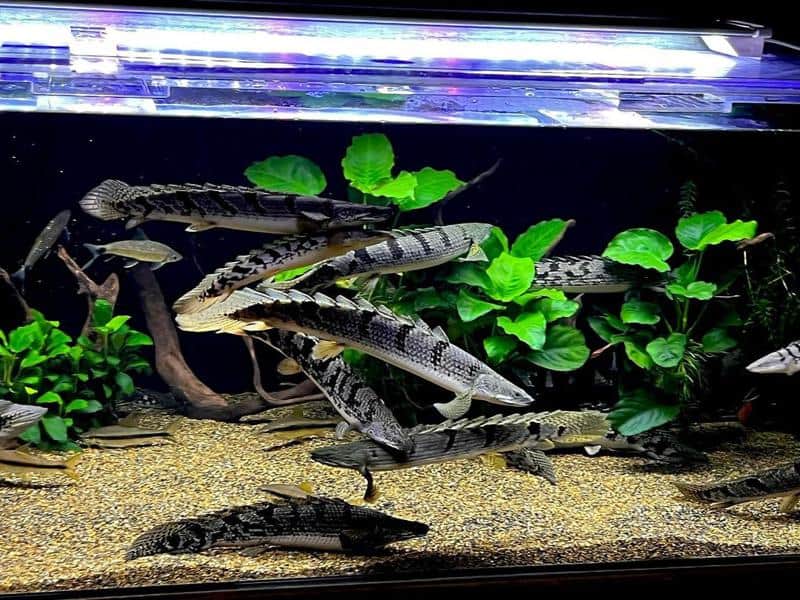
- Scientific Name: Polypterus bichir
- Care Level: Difficult
- Standout Feature: Dinosaur-like features
- Temperament: Aggressive
- Adult Size: 12 – 25 inches
- Minimum Tank Size: 90 gallons
- Diet: Carnivore
- Tank Setup: Sparsely set up tank with lots of open areas
Like the fire eel, the bichir also isn’t a true eel. However, it certainly plays the part well, with its perfectly eel-like appearance and behavior, and it is called the “dinosaur eel”.
This fish has been around worldwide for a long time. They have defined, overlapping armor-like scales that protect their body, a solid flat head, and powerful spined fins.
Juvenile bichirs look more eel-like with a uniformly thin body and a flat head, but adult bichirs grow into massive dragons that reach up to two feet in length.
If you’re looking for an eel to add a touch of wildness to your monster tank, there’s nothing better than this ancient fish to add to the list.
11. African Ropefish
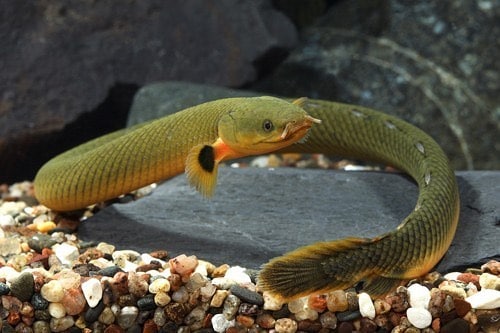
- Scientific Name: Erpetoichthys calabaricus
- Care Level: Easy
- Standout Feature: Slender shape and fine scales
- Temperament: Peaceful
- Adult Size: 15 inches
- Minimum Tank Size: 45 gallons
- Diet: Carnivore
- Tank Setup: Wide area with soft substrate and dense vegetation
A nice change of pace from the aggressive nocturnal predators of the list so far, the African ropefish is a gentle eel-like fish that even beginners can take care of.
As long as you have a big tank that they can swim around in, the African Ropefish is game. They are not true eels, but they appear very eel-like because they are elongated and slender.
However, looking closely, you can notice defined scales and fan-like pectoral fins. They also have a deep green coloration that makes them look elegant and somewhat serpentine.
They are known for their peaceful temperament, opening the way to various peaceful tankmates. They love soft substrates, dense vegetation, and a diet of small insects and frozen food.
12. Violet Goby
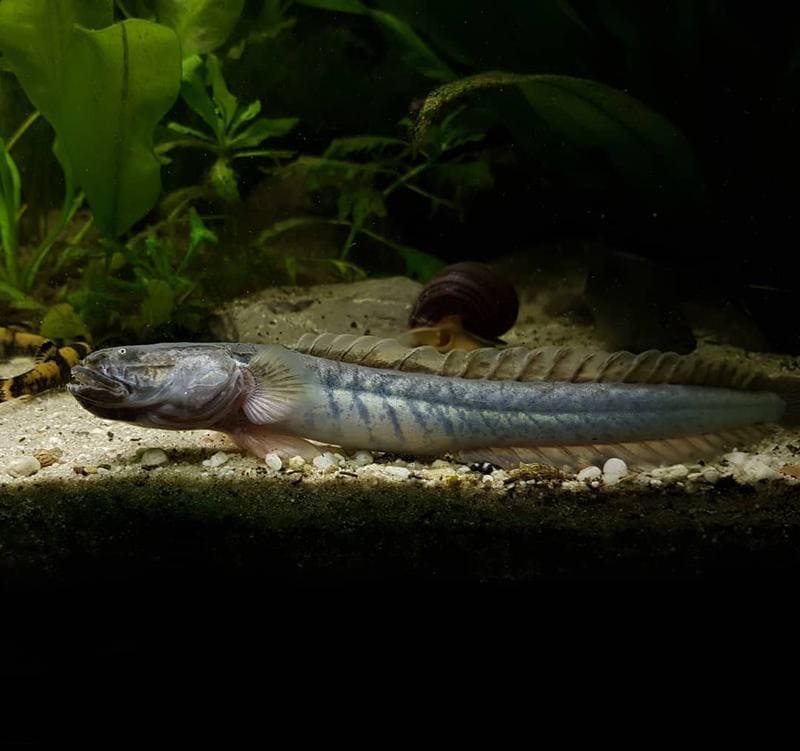
- Scientific Name: Gobioides broussonnetii
- Care Level: Experienced
- Standout Feature: Appearance and color
- Temperament: Peaceful
- Adult Size: 24 inches
- Minimum Tank Size: 50 gallons
- Diet: Carnivorous
- Tank Setup: Brackish water with fine sandy substrate
Also called the Dragon Fish Goby, this incredible and uniquely-colored fish makes an outstandingly proud addition to any experienced aquarium.
Like bichirs, they have a wild, prehistoric appearance that makes them look powerful and rugged. Added to their dark blue color, they make for a fascinating aquatic spectacle that will surely draw the fascination of any onlooker.
And just like bichirs, they also have an elongated, eel-like appearance. Their anal and dorsal fins are fused, creating a spade-like taper that adds to their appeal.
Despite their predatory look, these fish are scavenging bottom dwellers, and they’ll continue that behavior in the tank. Thus, it’s best to have a delicate, dark-colored substrate in your aquarium that won’t damage their sensitive underbellies.
With enough preparation and dedication, violet gobies are a fine centerpiece of any aquarium setup.
Also Read: Coolest Freshwater Fish For Your Aquarium
Basics of Freshwater Eel Care
If you plan on caring for freshwater eels in your aquarium, it’s important to know the basics. In this section, let’s discuss what you must consider when planning for your aquatic serpentine inhabitant.
Tank Size
Choosing the right tank size for your pet is critical because it directly affects how well they’ll live in your tank.
Eels can vary in size, but a general rule of thumb is to provide a baseline of 30 gallons of water for an eel tank. This will allow them just enough space to live and swim around.
For instance, in a 30-gallon tank, you can keep about two eels that grow to a max length of 15 inches.
Habitat Setup
These animals are nocturnal, so they sleep when the sun is out. As such, they love nooks and crannies that will hide them from predators that might be active during the day. Ensure that your tank has hiding spots. You can easily make some from driftwood, hardscape, or PVC pipes.
Also, remember that they spend most of their time in the bottom area of the aquarium, and some species even like to burrow into the substrate.
A good rule of thumb is to choose a fine or soft substrate type that won’t harm them as they move around in your tank.
Water Quality
Just like their fish cousins, maintaining pristine water conditions is crucial.
Regular water changes and a reliable filtration system are essential to check ammonia and nitrate levels. Eels are sensitive to water quality, so invest in a quality water testing kit and ensure that the filtration levels in your tank are optimized for their specific needs.
Eel Diet
Eels are carnivorous and need a diet rich in protein. Research your eel and offer a varied diet, including live or frozen foods like feeder fish, prawns, insects, and even earthworms, and other things that they might like.
Be sure to leave food for them in the evening when they are most active.
Compatibility and Tankmates
In general, you can house eels with other fish – but you need to do your homework, as some species can be especially territorial, and most are even hunters that might see smaller fish as snacks.
As a rule of thumb, don’t include fish smaller than them in their tank, as eels have no problems with eating those. They tend to leave larger species alone, though.
FAQs
Can You Touch a Freshwater Eel?
Yes, you can touch most freshwater eels, especially the ones that can be kept in aquariums. Some in the wild, though, such as the famous electric eel, generate large electric currents and injure a human being if touched.
Are Freshwater Eels Fish?
Yes, freshwater eels are a species of fish. Specifically, they’re a type of ray-finned fish under the Anguilliformes order. They have similar anatomies, except for a few key differences in their external appearances.
What’s the Smallest Freshwater Eel?
The smallest true freshwater eel is the yellow-tail spiny eel, which grows only up to 7 inches. However, many eel-like fishes are smaller, such as the cobalt blue goby, which only grows to about 2 inches.
How Big Do Freshwater Eels Grow?
Freshwater eels can range from 15 inches to more than 3 feet, depending on the species, especially if kept in ideal conditions.
Conclusion
The beauty of the aquarium hobby is that it’s full of possibilities. You can raise one of the hundred fish species, reptiles, and even eels! But just because you can do it doesn’t mean you should do it without preparation.
That’s what this article is for. And if you’ve managed to reach this far, you should be ready to start your eel aquarium!
